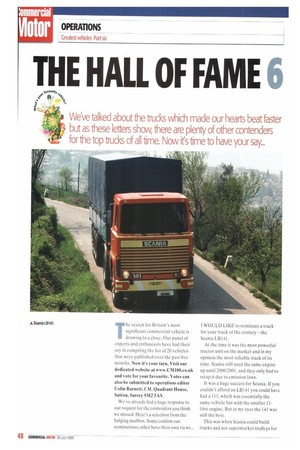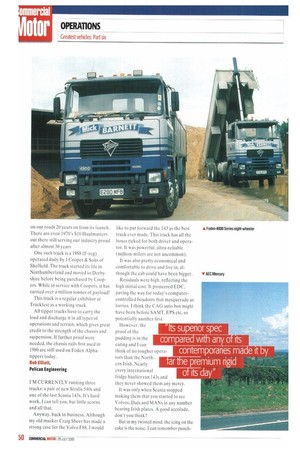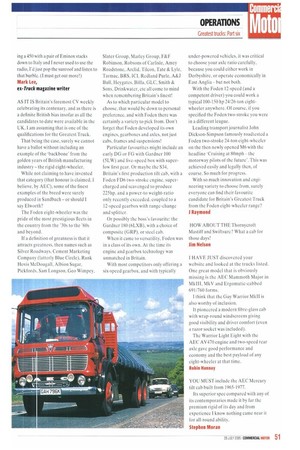THE HALL OF FAME 6
Page 48

Page 49

Page 50

Page 51

If you've noticed an error in this article please click here to report it so we can fix it.
We've talked about the trucks which made our hearts beat faster but as these letters shovv, there are plenty of other contenders
for the top -rucks of all time. Now it's time to have your say...
The search for Britain's most significant commercial vehicle is drawing to a close. Our panel of experts and enthusiasts have had their say in compiling the list of 20 vehicles that were published over the past five months. Now it's your turn. Visit our dedicated website at www.CM100.co.uk and vote for your favourite. Votes can also be submitted to operations editor Colin Barnett, CM, Quadrant House, Sutton, Surrey SM2 SAS.
We've already had a huge response to our request for the contenders you think we missed. Here's a selection from the bulging mailbox. Some confirm our nominations; other have their own views... I WOULD LIKE to nominate a truck for your truck of the century — the Scania LB141.
At the time it was the most powerful tractor unit on the market and in my opinion the most reliable truck of its time. Scania still used the same engine up until 2000/2001. and they only had to scrap it due to emission laws.
It was a huge success for Scania. If you couldn't afford an LB141 you could have had a 111, which was essentially the same vehicle but with the smaller 11litre engine. But in my eyes the 141 was still the best.
This was when Scania could build trucks and not supermarket trolleys for agency drivers. I can't see why your CM100 should even have the new R Series in it when the 4-Series was such a let-down with reliability.
If you had a 141 you were truly king of the road, when everyone else was in an ERF with a 240 Gardner.
Lucy Richardson TUT TUT... I really must point out that your list is incomplete without the presence of one of the all-time greats.
The Scania 141 V8 surely cannot be left off this list. Great idea to celebrate CM's 100th year, though.
Rikki Chequer TruckNet UK IN MY OPINION you missed out the truck that pioneered the way forward and led to today's range of quality bigspace sleeper cabs. This truck was, of course, the mid-'80s Daf 3300 Space Cab. Indeed it had more space in the cab than many of today's trucks.
The 1160 engine was very reliable and, coupled with the 16 speed ZF gearbox, it was more than capable of doing the job. I spent a good few years driving a 3300 on long-distance tramping work and I never had any complaints about it.
Another reason I fly the flag for this particular model (and am very biased) is that I actually own one of these truly remarkable trucks.
Chris Trickett DURING THE '70s I had experience with the Scania 110s and Volvo F86 and F88s so much lusted after by all professional drivers at the time.
However, for me the revelation was taking delivery of my first MAN 232. This had double bunks, an almost flat floor and, most important, a columnchange ZF six-speed constant-mesh gearbox with splitter.
It took me a week to get used to the box and I almost gave up. But after that, like the Fuller, it was possible to make clutchless changes, especially in the upper ratios. It also meant that nobody would take your vehicle for a night-trunk when you had a night at home! The roominess of the cab was exceptional, the cross cab access simple and you could stand up DAF 3300 Space Cab without bending your head — I had lived in smaller bedsits.
The engine was extremely smooth having, if I remember correctly, a spherical combustion chamber.
I moved onto a Volvo F10 eventually, but not until taking delivery of a TGA XXL automatic recently have I experienced a better environment.
Peter Mitchell, Black Mountain Foods AS AN ADDITION to your Hall of Fame feature I feel I must draw to your attention a truck well worthy of the title 'Greatest Truck Of Them All'.
Without doubt the Foden eightwheeler has out-lived all of the competition, with the 4000 Series still being seen on our roads 20 years on from its launch. There are even 1970's S10 Haulmasters out there still serving our industry proud after almost 30 years One such truck is a 1988 (F-reg) operated daily by J Cooper & Sons of Sheffield. The truck started its life in Northumberland and moved to Derbyshire before being purchased by Coopers. While in service with Coopers, it has carried over a million tonnes of payload!
This truck is a regular exhibitor at Truckfest as a working truck.
All tipper trucks have to carry the load and discharge it in all types of operations and terrain, which gives great credit to the strength of the chassis and suspension. If further proof were needed, the chassis rails first used in 1980 are still used on Foden Alpha tippers today.
Bob Elliott, Pelican Engineering
I'M CURRENTLY running three trucks: a pair of new Stralis 540s and one of the last Scania 143s. It's hard work, I can tell you, but little acorns and all that.
Anyway, back to business. Although my old mucker Craig Sheer has made a strong case for the Volvo F88, I would like to put forward the 143 as the best truck ever made. This truck has all the boxes ticked for both driver and opera tor. It was powerful, ultra-reliable (million-milers are not uncommon).
It was also pretty economical and comfortable to drive and live in, although the cab could have been bigger.
Residuals were high, reflecting the high initial cost. It pioneered EDC, paving the way for today's computercontrolled boudoirs that masquerade as lorries. I think the CAG auto box might have been before SAMT. EPS etc, so potentially another first.
However, the proof of the pudding is in the eating and I can think of no tougher operators than the Northern Irish. Nearly every international fridge haulier ran 143s and they never showed them any mercy.
It was only when Scania stopped making them that you started to see Volvos. Dafs and MANs in any number bearing Irish plates. A good accolade, don't you think?
But in my twisted mind, the icing on the cake is the noise. I can remember punch ing a 450 with a pair of Eminox stacks down to Italy and I never used to use the radio, I'd just pop the sunroof and listen to that burble. (I must get out more!) Mark Lee, ex-Truck magazine writer AS IT IS Britain's foremost CV weekly celebrating its centenary, and as there is a definite British bias insofar as all the candidates to date were available in the UK, I am assuming that is one of the qualifications for the Greatest Truck.
That being the case, surely we cannot have a ballot without including an example of the 'backbonefrom the golden years of British manufacturing industry — the rigid eight-wheeler.
While not claiming to have invented that category (that honour is claimed, I believe, by AEC), some of the finest examples of the breed were surely produced in Sandbach — or should I say Elworth?
The Foden eight-wheeler was the pride of the most prestigious fleets in the country from the '30s to the '60s and beyond.
If a definition of greatness is that it attracts greatness, then names such as Silver Roadways, Cement Marketing Company (latterly Blue Circle), Rank Hovis McDougall, Albion Sugar, Pickfords, Sam Longson, Geo Wit-Ivey, Slater Group, Marley Group, F&F Robinson, Robsons of Carlisle, Amey Roadstone, Arclid, Tilcon, Tate & Lyle, Tarmac, I3RS, ICI, Redland Purle, A&J Bull, Heygates, Biffa, CiLC, Smith & Sons, Drinkwater, etc all come to mind when remembering Britain's finest!
As to which particular model to choose, that would be down to personal preference, and with Foden there was certainly a variety to pick from. Don't forget that Foden developed its own engines, gearboxes and axles, not just cabs, frames and suspensions!
Particular favourites might include an early DG or FG with Gardner 100 (5LW) and five-speed box with superlow first gear. Or maybe the S34. Britain's first production tilt cab, with a Foden FD6 two-stroke engine, supercharged and scavenged to produce 225hp, and a power-to weight-ratio only recently exceeded, coupled to a 12-speed gearbox with range-change and splitter.
Or possibly the boss's favourite: the Gardner 180 (6LXB), with a choice of composite (GRP), or steel cab.
When it came to versatility, Foden was in a class of its own. At the time its engine and gearbox technology was unmatched in Britain.
With most competitors only offering a six-speed gearbox, and with typically under-powered vehicles, it was critical to choose your axle ratio carefully, because you could either work in Derbyshire, or operate economically in East Anglia — but not both.
With the Foden 12-speed (and a competent driver) you could work a typical 100-150 hp 24/26-ton eightwheeler anywhere. Of course, if you specified the Foden two-stroke you were in a different league.
Leading transport journalist John Dickson-Simpson famously roadtested a Foden two-stroke 24-ton eight-wheeler on the then newly opened M6 with the headline 'Cruising at 80mph — the motorway pilots of the future'. This was achieved easily and legally then, of course. So much for progress.
With so much innovation and engineering variety to choose from, surely everyone can find their favourite candidate for Britain's Greatest Truck from the Foden eight-wheeler range? 1 Raymond HOW ABOUT THE Thornycroft Mastiff and Svviftsure? What a cab for those days! Jim Nelson I HAVE JUST discovered your website and looked at the trucks listed. One great model that is obviously missing is the AEC Mammoth Major in MkIII. MkV and Ergomatic-cabbed 691/760 forms.
I think that the Guy Warrior MkII is also worthy of inclusion.
It pioneered a modern fibre-glass cab with wrap-round windscreens giving good visibility and driver comfort (even a razor socket was included).
The Warrior Light Eight with the AEC AV470 engine and two-speed rear axle gave good performance and economy and the best payload of any eight-wheeler at that time.
Robin Hannay
YOU MUST include the AEC Mercury tilt cab built from 1965-1977.
Its superior spec compared with any of its contemporaries made it by far the premium rigid of its day and from experience I know nothing came near it for all-round ability.
Stephen Moran






































































































































































































